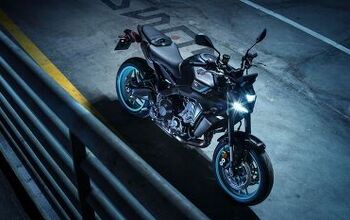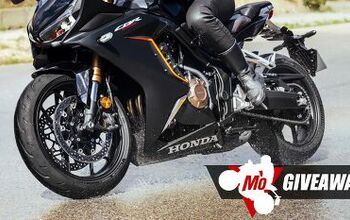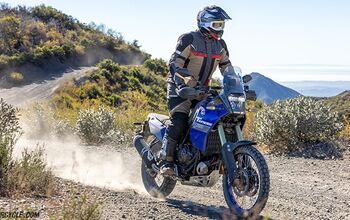
It's a hot, sweaty night in Sepulveda. Lined up at the lights, four motorcycles. Racing for pink slips. The light flickers from red to green, hammers down, they're gone in a wisp of smoke and a black squeal of tires. Who wins? For our Musclebike contest we picked Yamaha's V-Max, Triumph's Speed Triple, Honda's CB1000 and Ducati's M900 street rods. As hot rod cars get more and more popular on the streets of the USA, can hot rod motorcycles be far behind? Well, actually, yes. The naked musclebikes that the rest of the world is demanding, and getting, haven't reached these shores. Bikes like Suzuki's 1200 Bandit, Yamaha's FJR 1200 and TRX 850. What the rest of the world doesn't have is Buell's S1. Unfortunately, at the time of this
4th place Yamaha V-Max
It's not the original musclebike -- the Vincent Black Shadow was probably that -- but it's been around since the beginning of time. Well, at least since 1984, and that makes the 1198cc V-four cylinder V-Max one of the longest-lived motorcycles, and also one of the most unchanged. New brakes and all-black paint were the only changes for '96. When it debuted more than a decade ago, the Max machine was astounding, offering more power than just about anything without wings and a Pratt and Whitney engine, all in a chassis that appeared to be deliberately designed for the street drag racer, who didn't have to turn corners.
It never was a handler, even back then. And every other powerful motorcycle on the market was big and heavy, so its substantial weight wasn't a disadvantage. Nowadays, with a new generation of lightweight motorcycles to compete against in the traffic light Grand Prix, its bulk is noticeable. On our brand new V-Max, even before it's stock rear tire (the V-Max is shod with low-lifetime Bridgestone Exedras) went bad, handling was, shall we say, interesting. It's quite a feeling to gingerly feel your way around a corner, throttle carefully feathered, as the forks pogo and the front wheel threatens to push every inch of the corner.
Try to corner hard, and you'll regret it, as the front wheel starts to push and the back pogos all over the place. It is fairly easy to lean over enough, at least on a smooth road, to scrape the pegs. As a practical, day-to-day motorcycle the Max is a little overwhelmed. The 4.0 gallon gas tank lives under the seat (the dummy tank actually contains the airbox and the header tank for the radiator), and to refill it, which you have to do after you hit the electric reserve button at around the 100 mile mark, you must first pull two underseat mounted toggles. Then, to the delight of gas station attendants everywhere, the mid part of the seat bursts open, revealing the lockable filler cap below.
3rd place Triumph Speed Triple
We had our doubts about including the Triumph in the test: After all, at only 885 cc, it gave away capacity to the multi cylinder competition and much weight to the twin cylinder rival (the Ducati). And at first the motor seemed low-powered: That was until we ran all the bikes away from the lights at once, and the Triumph took the lead. It's a great motor once you realize it has to be revved. There's not too much power down low in the rpm range, but get that three cylinder motor spinning and it pulls with alacrity. Carburetion glitches seem to hamper the Triumph in the midrange, and we're sure that a little tuning would help the gas consumption: the Triple was the thirstiest of the lot, even out-gulping the V-Max into the low thirties when both were ridden side by side.
For a sporty motorcycle, the Triumph sure has a lousy suspension setup. Both ends of the bike are underdamped and undersprung. The frame, (the same type used for all Triumph models), is a tubular steel spine type, and means the bike is high (too high for some short-legged riders: One of the reasons Triumph's Thunderbird is popular is that shorter riders can get their feet on the ground). Combine the height with the mushy, wallowy suspension and uncertain handling and you have a recipe for rider distrust. These criticisms have been leveled at Triumph for several years now, and we're beginning to wonder why they don't fix up the suspension to suit the sporty image they've adopted. True, very few Triumph owners will push their bikes to the limit, but the competition (even the big, wallowy Honda) is just so much better around the bends. Heck, even the V-max wasn't that much worse.
Given these criticisms, it probably doesn't really matter that the Triumph was shod with slightly long in the tooth Michelin Hi Sports, which aren't famous for their responsiveness. Bridgestone Exedras would have worked just as well. The Speed Triple has potential for the top of the musclebike class - but it doesn't quite know what it wants to be. The riding position is a compromise between sportbike and standard. Low footpegs and knee cutouts in the tank are the sporty bits. Narrow handle bars lack musclebike leverage. The tires fitted were lacking feel in hard sporty cornering (although nobody expects a musclebike to corner well). Compromises in the suspension let this motorcycle down: but even with its compromised design, if it had been a smoother suspended performer, it would have been hard to beat on the street. For: Character, soulful wail of three cylinder motor. Good brakes. Surprising peak power Against: Hi-strung, peaky power, odd riding position nobody liked, spongy front suspension.

Motorcycle.com presents an unrivaled combination of bike reviews and news written by industry experts
More by Motorcycle.com Staff
































Comments
Join the conversation